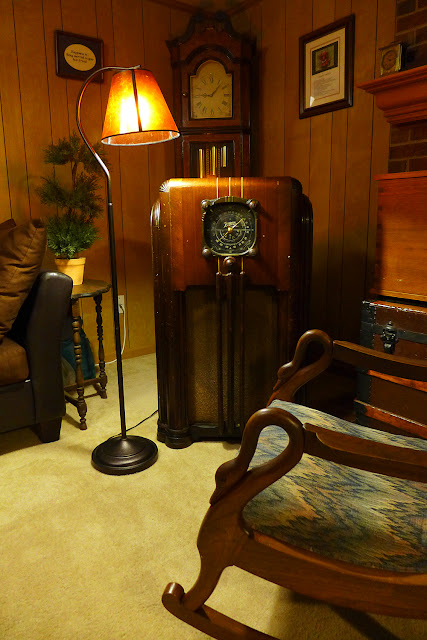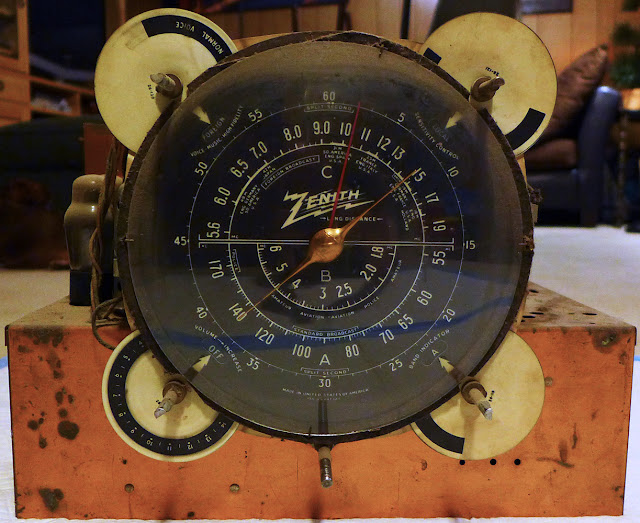September 2, 2020
#401
Gentle reader,
My brother-in-law, married to my baby sister, is from Upstate New York. His Grandparents lived on a farm up there all their lives.
While today most people living in the United States take running water, electricity, landline telephones and even broadband Internet for granted, well into the 20th Century there were STILL millions of citizens who relied on a hand-pumped well for water, an outhouse to do their business and candles or oil lamps for light when the sun went down.
Bob's grandparents and their children were one of the millions who knew no better than the way they lived like people had done so for hundreds of years.
Also, something people did without was television. Firstly because it was not invented and available (for the wealthy) until the early 1940's. Now we can watch what we want, when and where we want and on countless devices.
But long before all that, people relied on word-of-mouth and if they were available in their area, newspapers, for news of what was happening outside their small wold.
Some electronics companies, rather than ignore those non-city dwelling people, saw an opportunity to fill a niche. They took some of their radios and made them able to be operated with a battery.
How did one charge that battery? Well, like a windmill was used to pump water out of the well and to provide power to run all kinds of tools, there were also wind-driven battery chargers for the farm's battery.
Now, you may be thinking, "Battery? Everything runs on batteries!" Not in the 1930's. Automobiles and trucks of all sizes used six-volt wet-cell batteries, similar to this one below.
Called "wet cell" because inside is either hydrochloric acid wetting lead plates to provide the power. Some larger wet-cell batteries use and alkaline solution instead. BOTH will burn you if not careful.
Nowadays, and since the 1970's, cars and trucks use twelve-volt (or sometimes multiples of 12) batteries to start their engines.
Thanks to TubeRadioLand.com for finding this ad and displaying it on your site.
$89.95 in 1937 dollars is equivalent to $1,652.92 today. A LOT of money for a radio!
The ads above and two images below are from this website: Zenith Model 8-S-154H (8S154H) Console Radio with Rare Maple Finish (1937)
This is the same radio as Bob's grandparents had on their farm. It is in far better condition than one that lived in a farmhouse heated by firewood.
We did not take "before" photos because we began cleaning out the DECADES of dust and cobwebs the radio had accumulated during it's eighty-three year lifetime.
The speaker had been removed and the wires were cut prior to Bob giving it to us. As we were carrying it across their family room, one of the tubes fell out. Fortunately they have thick soft carpeting and the tube's "chimney" protected it. More on that later.
That dust gets everywhere is true, even UNDER the radio's chassis.
I did not know when plywood was invented, but it sure existed in 1937 because some of the structure is made of it.
I know what speaker transformers were for, they used DC voltage to carry the sound long distances in large building PA systems for instance.
But this radio uses one which the other one (shown above) does not. The speaker is twelve inches in diameter. What would be considered a large "woofer" these days, it was a full-range "High Fidelity" speaker almost 100 years ago.
As you can see, we cleaned off dust and grime where we could reach it while the radio was in one piece. Cover was off the transformer housing too. But it came with the radio to us.
The thick red and black wires coming out of it are to hook to the battery which sat on the floor of the radio beneath the speaker.
Four of the six vacuum tubes have metal "chimneys" around them. It seems counterintuitive to me but they must have been designed to help funnel the tube's heat upward.
Inside the steel box (above and below) are two transformers (rectangular objects with round sections) and two capacitors.
The larger transformer changes the six volt DC power to a MUCH higher power to run the tubes which require HUNDREDS of volts to work. Induction is the magic of transformers that makes that happen.
The tube which fell out is the one on the right, above. The finned device between the square metal objects is the tuner. The "combs" rotate between other fixed fins to tune in certain frequencies. In the case of this radio MANY frequencies.
The tuning dial with four switches surrounding it. A photo down below shows a better look at the dial (after cleaning) which shows how many different types of radio this was capable of receiving.
The four shafts with white/black dials are for various functions, lower left one is the on/off and volume control switch.
I carefully removed each tube and the wire that connects to the terminal that is atop the four tubes with chimneys. I carefully cleaned them and all the components I could get to while also carefully trying not to break or damage any wiring.
Well into the 1970's at least, there were TUBE TESTER machines in MANY stores in the US and around the world. I remember going with my Dad with a bag of tubes to the local Rexall Drugs store and helping him use the machine to see which tube(s) might be bad.
Transistors, and now integrated circuits, will never have the visual appeal of tubes.
While I have worked on and with electronics since the 1970's, as an amateur and professionally, I have never worked on anything with tubes. So, this is a cosmetic restoration of this radio.
Those square metal covers house I know not what beneath. One of the many reasons I am not attempting to get this radio working.
Old tube equipment is very liable to spark and possibly start burning if one simply plugs it in (or in this case hook up a six-volt battery to it) and then turns it on to see what will happen.
Below is the underside of the radio's chassis.
For example, the large red and black wires the other end of which have battery cable clamps on them, are missing insulation right where they enter the chassis, above.
The large metal wheel is a flywheel that is attached to the main shaft below the tuning dial. The AD refers to the radio's "Lightning Station Finder" and that is the flywheel. The fabric belt and strings that once wound around it and made the tuner and tuning dial rotate, were of course broken, so I removed the pieces.
For safety's sake, I cut off the 83 year old red and black wires and threw them away. I also removed the pieces from the clamp (above) so that none of our kids might get hurt after we are gone.
Much less dust and dirt inside now.
Fortunately, whomever cut the speaker wires did them individually and at separate places so that matching them up by color and soldering them together much easier.
Transformer cover back on, I had to find the appropriate screws to secure it, and everything as clean as I could safely get it. Nice shiny tubes once again.
"A" is for antenna and a piece of wire was still hanging on to the screw terminal.
Speaker's five-pin plug is back in place on the radio chassis.
A shame the chimneys block the view of the tubes.
I suspect the yellow ring of plywood covers a hole big enough to hold a fifteen inch woofer. Possibly used in larger model console radios.
The following images show the radio laying flat so that I could (after considerable further cleaning of the wood) apply lemon oil to all wooden surfaces to restore life to the ancient wood.
Nice and shiny once again.
Nicks, chips and scratches do not bother us, it shows the long life the radio endured in the wilds of upstate New York.
If you look at the rear of the bottom of the radio, you can see it was wet many times. In fact, some pieces were crumbling off as I added feet to the back corners.
These are what I used to safely finish cleaning and restoring the wood. The GRIME we removed from it!
Each of the knobs are wooden and have Zenith's lightning bolt stylized "Z" on them.
If you click on any photo (or enlarge them with your fingers on a portable device) the photo will open over this page much larger. Then you will be able to see all the fascinating information the dial holds.
I made this image black and white to make it look more era-correct. While it would be awesome to have the radio working, the only frequencies it would still be able to receive are AM radio. All the other ones which people might listen to are now using much more modern (and thus unable to be received by this) and higher frequencies, if not in fact via satellite radio.
I have bought "retro" radios as well as other tube radios over the years. And written about them as well.
The black metal one above and below was Nancy's fathers and it still worked when we inherited it.
The wooden one on the top shelf, below, is also tube and it did work when I bought it and later sold it.
Above is a retro floor radio I was delighted to find. It is large but much smaller (and lighter than) the Zenith. I wrote about it here: The Robb Collections: I found a floor radio. What's a floor radio? They Were Called Console Radios Once. Take a look.
This 1960's Zenith radio is also tube, but all I could get out of it was a buzzing sound.
Older articles I wrote about our radio collection are listed below in order of writing.
The last article deals with a modification to the floor radio which greatly improved it's sound.
Thank you SO much for taking the time to read this article. Hopefully you learned somethings as well.
Please take a moment to click FOLLOW above which is below the long list of article dates and leave a comment below or on Facebook.
Scott & Nancy
September 2, 2020
#401










































